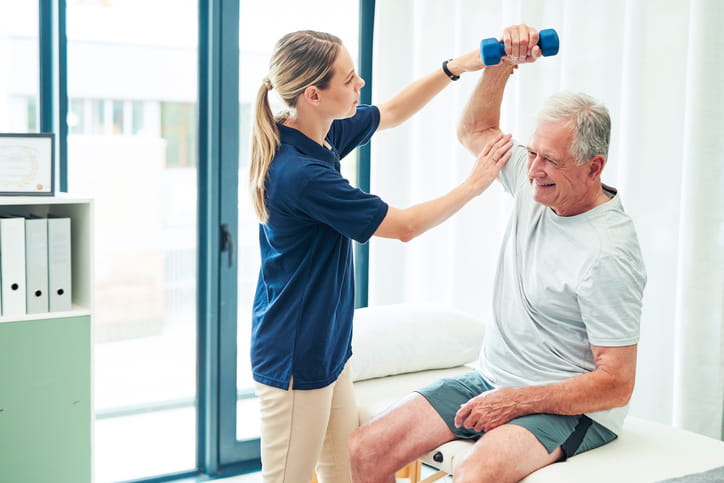Can Physical Therapy Help Arthritis?

Arthritis is one of the most common health conditions around the world, affecting almost 60 million adults just in the United States alone. This potentially debilitating condition causes joint stiffness, swelling, and chronic pain. It can even cause a reduced ability to perform daily tasks and enjoy life.
There is no cure for arthritis. However, in many cases, the condition can be effectively managed with medicine, lifestyle changes, and most importantly, physical therapy. PT is a particularly great option as it’s non-invasive, doesn’t involve new medication, and exercise is fantastic for mental health.
Today, we’ll take a look at arthritis, how physical therapy may be able to help, and how Monument Health Group can help you achieve your best life in your golden years, arthritis or not.
Understanding Arthritis
Despite popular opinion, arthritis isn’t just one disease. It’s actually a broad spectrum of conditions affecting the joints. In fact, there are more than 100 different types of recognized arthritis today.
The most common forms of arthritis include:
- Osteoarthritis: This is one of the common forms of arthritis associated with aging. This type of arthritis is caused by wear on the cartilage of the joints.
- Rheumatoid arthritis: Rheumatoid arthritis is an autoimmune disease, meaning the body accidentally attacks itself. In this case, the body attacks joint tissues.
- Gout: Gout is a condition involving buildup of urate crystals in the joints. It most often affects the big toe, and can happen to just about anyone.
- Psoriatic arthritis: This is a type of arthritis that sometimes affects people who have the skin condition psoriasis. It’s characterized by swollen joints.
- Fibromyalgia: Fibromyalgia is a condition little understood by science. It causes intense pain throughout the body, and may be genetic.
- Lupus: Lupus is another autoimmune disorder that sometimes attacks joints. More than a million people in the U.S. have this condition.
How Arthritis Affects The Body
Because there are so many different types of arthritis, each may require different treatments. Arthritis can also lead to other symptoms in addition to joint pain, such as fatigue, reduced mobility, and more. Physical therapy for arthritis may be a good technique to combat these effects depending on your unique situation.
Can Physical Therapy Help Arthritis?
The short answer to this question is yes, depending on the type of arthritis, physical therapy can help reduce symptoms and potentially even slow the progression of the disease.
Arthritis physical therapy treatment can:
- Reduce pain naturally without relying solely on medications.
- Improve flexibility to help with mobility.
- Improve strength to support joints and compensate for other infirmities.
- Improve mobility as well as balance.
- Protect joints from further decay or injury.
- Support joint health and even slow the progression of arthritis.
Importantly, individualized treatment is necessary, depending on the type of arthritis, patient needs, and progression of the disease. Any good physical therapist will create a customized treatment plan to target your specific condition and address specific needs.
Physical Therapy Techniques For Arthritis Treatment
A number of techniques regularly used by physical therapists can be used to treat various different types of arthritis.
Among them include:
- Exercise programs: Exercise programs can be used to strengthen muscles and improve flexibility and mobility. Some excellent low-impact activities may include walking and swimming, stretches and other flexibility exercises, and various types of strength training, including light weight lifting and use of exercise bands.
- Manual therapy: Manual therapy includes techniques such as stretching and massages that can ease muscle tension, reduce stiffness and increase flexibility, and even improve circulation near joints.
- Assistive devices and training: Assistive devices include the use of aids like braces, walkers, canes, and other devices that can help relieve pressure from joints, improve independence, maintain safety, and more.
- Education and lifestyle guidance: Perhaps one of the most overlooked facets of physical therapy is the education and lifestyle guidance that comes with it. This includes things such as posture guidance, pacing activities, and advice on diet and exercise to keep symptoms at bay and at a minimum.
Benefits Of Physical Therapy For Arthritis Patients
Many people who choose to undergo physical therapy report great improvements in how they feel, a reduction in symptoms, and better management of the disease overall. Benefits of arthritis treatments for physical therapy include:
- PT can help patients reduce pain and stiffness.
- PT can improve mobility and independence.
- PT can enhance long-term joint protection.
- And perhaps most importantly, PT almost always boosts overall quality of life.
For many people with arthritis, physical therapy becomes an integral part of their lives. Many patients even look forward to physical therapy due to the inherent physical and mental health benefits from exercise and lifestyle advice that comes with the therapy.
When To Consider Physical Therapy
If you’ve been diagnosed with arthritis, or you suspect you may have the condition, it’s best to consult with a doctor or physical therapist as early as possible. The earlier you take action, the better the chances you have of managing the condition before it gets worse.
Consider speaking with a physical therapist:
- After diagnosis of arthritis.
- When pain begins to interfere with daily life.
- To avoid or delay surgery.
- As part of a comprehensive arthritis treatment plan, alongside medications, injections, or other therapies.
- When you want guidance on safe exercise and diet to help reduce symptoms.
Physical Therapy For Arthritis FAQ
Is Physical Therapy Right For Your Arthritis?
Physical therapy is a safe, effective way to reduce pain, improve mobility, and restore quality of life for those with arthritis. No matter the type, and especially for older Americans, physical therapy is an important part of a comprehensive treatment plan for effectively managing arthritis.
If you have arthritis, speak with your healthcare provider or physical therapist about the best treatment plan depending on your unique situation.
How Monument Health Group Can Help
At Monument Health Group, arthritis care is supported through personalized physical therapy programs, designed to reduce pain and improve mobility. Our patients benefit from expert guidance, safe exercises, and hands-on therapy tailored to their condition.
Our team focuses on improving independence, preventing further joint damage, and supporting overall quality of life.


